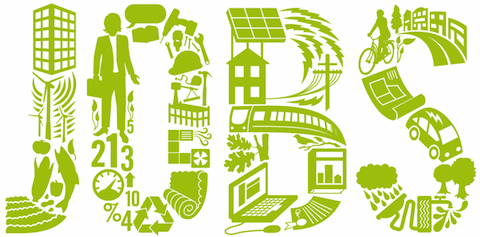 Image: Climate ProgressCross-posted from Climate Progress.
Image: Climate ProgressCross-posted from Climate Progress.
The past few weeks have seen a perfect storm of misinformation on green jobs: What they are, how many there are, how much they contribute to the economy. Many of those throwing numbers around have relied on one source, a recent report from the Brookings Institution, which worked with Battelle’s Technology Partnership Practice to attempt to define, evaluate, and count green jobs as a part of the economy from 2003-2010.
It is clear to those of us who have been deeply engaged in making the case for green jobs for years that the Brookings report has been almost universally misunderstood. Hence this post to try and clear up some of the details. But first, a digression about green jobs.
The phrase “green jobs” does not stand for, and in fact has never stood for, one specific set of occupations that can be set aside and easily counted. In this, green jobs are not unique. Think about “high-tech jobs,” for instance. There are jobs in inventing and developing software, to be sure. But there are also jobs in using software to make existing companies more productive and efficient. There are manufacturing jobs associated not only with the hardware in our computers, but with the servers we use to store data. There are construction jobs that would not exist were it not for the need to build server farms. All the jobs that have come about because of the invention of the computer, and the transformation of our economy from a low-tech to a high-tech one, are arguably “information technology jobs.”
Similarly, “green jobs” go way beyond the obvious jobs, like the wind turbine operators. They span huge numbers of industries and occupations, and touch nearly every sector of the economy because they can include all those who use cleaner or more efficient energy and fuel, as well as those who invent, manufacture, install, operate, and maintain those things. Just like the phrase “high-tech jobs” has come to stand for an entire economic transformation toward computerization of nearly everything we do, so does “green jobs” stand for a huge transformation in the kinds of energy we use to underpin our long-term economic growth.
So, back to the Brookings report. In that report, Brookings researchers tried valiantly to pin down at least some of the industries and occupations that are most clearly associated with the green economy transformation. They did an admirable job, and here’s what they actually found:
- A lot of people already have green jobs. Brookings found that there are currently 2.7 million jobs in the clean economy, as broadly defined to include not just mature industries like manufacturing, transportation, and public services, but also emerging industries like solar, wind, and battery technology. It also includes conservation and restoration jobs. That’s 2.7 million people who have jobs because their employers, cities, or states — or their country, through the Recovery Act — prioritized moving away from dirty fossil fuel use and toward mass transit, or clean energy, or energy efficiency services — or because they have realized they need to clean up the mess left by generations of fossil fuel use.
- Green jobs are part of a growing, not a shrinking, sector of the economy — and some green industries are growing incredibly fast. Broadly defined, the clean economy — again including transportation, restoration, efficiency, clean energy, etc. — grew at 4.3 percent from 2003-2010, adding half a million new jobs. Pause to think about that: That’s half a million people who now have jobs in these sectors, and might not have jobs at all if their companies, cities, and states hadn’t decided to become a little cleaner and greener. The part of the clean economy sector that is focused on clean energy in particular — the wind, solar, fuel cell, smart grid, biofuel, and battery companies — grew far more quickly, at an average rate of 8.3 percent, which is nearly twice the growth rate of the economy as a whole.
- The overall clean economy grew during the recession, but was not exempt from its impacts. Given the huge growth in clean energy and fuel sectors, you’d think we’d see a higher overall growth rate for the clean economy as a whole. What kept that growth from being more explosive? The same thing that brought down the economy as a whole and threw us into recession: the housing crisis. A lot of green jobs are in construction, because green building and energy efficiency retrofits are such a fantastic way to bring down energy costs and lower our carbon footprint. Just like the rest of the construction sector, this part of the clean economy suffered when the bottom fell out of the housing market. But even given that fact, we still saw 4.3 percent growth, because not all green jobs are construction jobs.
- That gets us to the next point: Green jobs are spread across industries and occupations. You can find them in everything from research and development, to manufacturing, to construction and installation, to operations and maintenance, to retail and service. Unlike jobs in the much-touted real estate and finance sector, they are not all concentrated into a relatively small set of occupations. That means that when the bottom fell out of the real estate and finance markets, there was still growth across all green jobs sectors. Similarly, when gas prices went up this past summer, as they invariably do, the parts of the green economy that are focused on alternative vehicles and fuels were suddenly a hot spot for growth. This diversification across occupations and industries makes the green economy smarter, more secure, and more sustainable than the economy as a whole.
- Green jobs are spread across regions, too — also unlike a lot of jobs in the financial sector, which tend to be concentrated in big cities on the coasts. Brookings found that of all regions in America, the South has the highest concentration of jobs in the broader clean economy.
- Green jobs are good jobs for all Americans, not just the small number with college degrees. Finally, Brookings found — as we and others have found in the past — that a lot of green jobs are in what are sometimes called “middle-skill” occupations, meaning that they require education and skills beyond high school, but not necessarily up to the four-year college level. Twenty-six percent of clean economy jobs are in manufacturing, which is a sector where workers with specific technical skills, but no bachelor’s degree, can make a solidly middle-class living. Why do we care? Three big reasons: First, nearly 70 percent of our workforce lacks a four-year college degree. That’s a lot of people shut out by high-skill industries. Second, middle-skill jobs have always been the key to America’s middle class
. Build an economy that only creates high- and low-skill jobs, and you build an economy with vast income inequality. And third, when we build up the manufacturing sector here in America, we can export our products to other countries, making us competitive in the global economy.
Those are some of the facts about the new clean economy. It goes beyond clean energy, though that is probably the most exciting and high-growth sector. A green jobs growth strategy spans industries, occupations, skill levels, and geographic regions, making these businesses and workers less vulnerable to price spikes, extreme weather events, recessions, attacks — you name it.
And most important, the clean economy is real. It employs real people in real jobs with real salaries — something at I bet the 14 million Americans who are currently unemployed sure wish they had.



